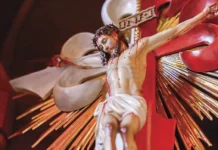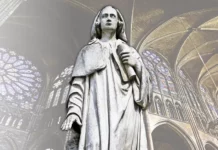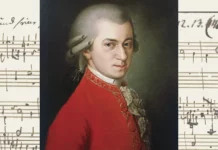Admiration for the testimony of the martyrs prompted the first Christians to venerate their relics and to ardently desire to follow their example.
It was an afternoon of feasting in the amphitheatre of Smyrna, around the year 155 of the Christian era. A bloodthirsty crowd packed the stadium, eager to witness a cruel spectacle: the martyrdom of 12 Christians. At the appointed time, the holy Bishop Polycarp—a venerable man of almost 90 years—stepped into the arena and scanned the crowd.
He was led to the presiding proconsul, who proposed to him a sure way of circumventing torture and death: cursing the name of Jesus. “I have served Him for eighty-six years and He has done me no wrong. How can I blaspheme the King who has saved me?”1 retorted Polycarp.
Seeing the futility of the attempts to lead the holy man into apostasy, the magistrate thundered:2
“I will have you burned at the stake if you do not change your mind.”
“You threaten me with fire that burns for a moment, and then goes out, because you are ignorant of the fire of the future judgement and of the everlasting torment reserved for the impious. But why do you tarry? Carry out your wish,” responded the Bishop.
In short order, the pyre was prepared and lit, and at that moment, a prodigy occurred. The flames formed into a type of bowed vault, like the sail of a ship filled with wind, surrounding the martyr’s body. There he stood, not as flesh being burned, but like bread in an oven, like gold or silver shining in the furnace. The fragrance of incense filled the air. With no more ado, at the order of the magistrate, the executioner killed Polycarp with dagger blows.
To prevent the Christians from carrying off that holy body, worthy of veneration, the roman centurian ordered it to be burned. Later, however, the faithful managed to recover his bones, “more precious than precious stones and more valuable than gold,”3 and deposited them in a fitting place.

A form of devotion that goes back to the first century
The narration of St. Polycarp’s martyrdom has come down to us in a letter written some time after his death by the Church of Smyrna and Philomela. It is the oldest known document that testifies to the custom of venerating the relics of the Saints in the early Church. But the custom, in itself, is older; a not uncommon opinion is that it began with St. Stephen.
Accordingly, for example, a half a century before St. Polycarp, St. Ignatius of Antioch was also afforded the glory of being condemned to death, in this instance, by being torn apart by wild animals. Both Bishops were disciples of St. John the Evangelist, and their holiness was so resplendent that even during their lives they had garnered countless manifestations of veneration from the faithful.
The entrance of Ignatius into the Coliseum of Rome was welcomed with roars from a crowd impatient to see blood. The doors of the cages were opened and famished lions bounded into the short space separating them from the man of God, accomplishing his desire to be crushed like wheat by the wild beasts.4 But when night descended over the colossal amphitheatre and some of the Christians entered the arena, hoping to recover at least a handful of sand bedewed with drops of blood, great was their joy to find the intact femur and heart of the holy Bishop!
Commemorating the “dies natalis”
The martyrs are imitators of Christ, following in the Divine Master’s footsteps, and confronting suffering and death for His sake. “We justly love them as disciples and imitators of the Lord, because of the incomparable devotion that they had for their King and Master”5 —affirmed the faithful of Smyrna upon requesting the body of St. Polycarp from the proconsul.
The admiration awakened by these heroes of the Faith in the Christian communities made many other faithful hearts burn with the desire to die for Christ. The testimony of those who had been martyred inspired these souls with the fervent desire to love God unto the very holocaust of their lives.
It is not surprising, then, that the Christian assembly commemorated their dies natalis by lovingly reading the narrations of their martyrdom. Once again, it is the faithful of Smyrna who testify to this desire: “Whenever possible, and the Lord permitting it, we gather, with rejoicing and gladness, to celebrate the anniversary of their martyrdom, to remember those who have gone before us in combat, and to exercise and prepare those who should wage future combats.”6
Once the period of persecutions had died down, the Christians gradually turned their attention to the non-martyr Saints. Over the centuries, the Holy Church promulgated laws to organize and regulate the exterior acts of this cult, such as we know it today.
The benefit that these feasts bring
Let us admire this example and, together with those who have gone before us in the Faith, let us learn to love those who willingly shed all of their blood for love of Christ crucified, and imitate their testimony.
With this in mind, it is fitting to close these lines with a beautiful and instructive quote of Saint Augustine: “The solemn homage we pay the martyrs in no way benefits them. They have no need of our celebrations, for they enjoy the happiness of the Angles of Heaven; and if they participate in our pious rejoicing, it is not because they feel honoured by seeing themselves imitated by us. Nonetheless, although our tributes do not benefit them, they are useful to us. But if we honour them without imitating them, we simply practice deceitful adulation. Why, then, were these feasts instituted in the Church of Christ in their praise? In order to remind the united members of Christ of the need to take these martyrs as models. This is, without doubt, the benefit afforded by these feasts; there is no other.”7 ◊
Notes







